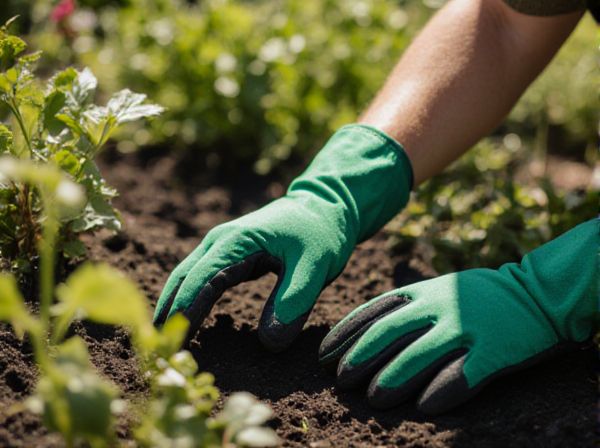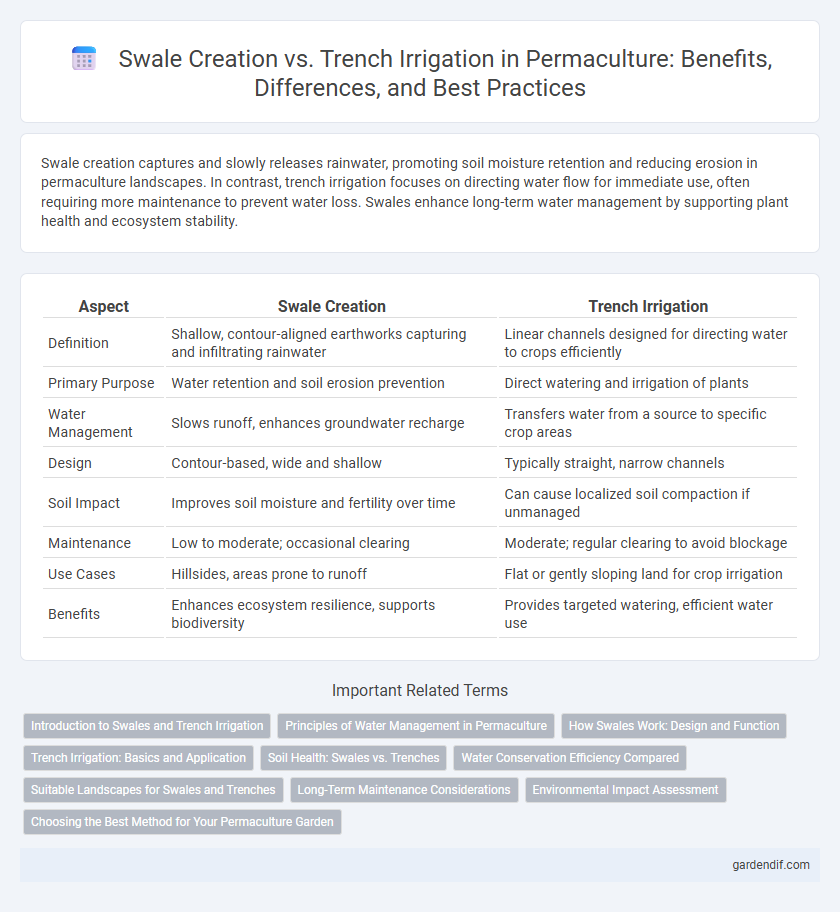
Swale creation vs Trench irrigation Illustration
Swale creation captures and slowly releases rainwater, promoting soil moisture retention and reducing erosion in permaculture landscapes. In contrast, trench irrigation focuses on directing water flow for immediate use, often requiring more maintenance to prevent water loss. Swales enhance long-term water management by supporting plant health and ecosystem stability.
Table of Comparison
| Aspect | Swale Creation | Trench Irrigation |
|---|---|---|
| Definition | Shallow, contour-aligned earthworks capturing and infiltrating rainwater | Linear channels designed for directing water to crops efficiently |
| Primary Purpose | Water retention and soil erosion prevention | Direct watering and irrigation of plants |
| Water Management | Slows runoff, enhances groundwater recharge | Transfers water from a source to specific crop areas |
| Design | Contour-based, wide and shallow | Typically straight, narrow channels |
| Soil Impact | Improves soil moisture and fertility over time | Can cause localized soil compaction if unmanaged |
| Maintenance | Low to moderate; occasional clearing | Moderate; regular clearing to avoid blockage |
| Use Cases | Hillsides, areas prone to runoff | Flat or gently sloping land for crop irrigation |
| Benefits | Enhances ecosystem resilience, supports biodiversity | Provides targeted watering, efficient water use |
Introduction to Swales and Trench Irrigation
Swales are contour-aligned shallow ditches designed to capture and slow water runoff, enhancing soil moisture retention and promoting groundwater recharge in permaculture landscapes. Trench irrigation involves digging narrow channels to direct water flow efficiently to plant roots, maximizing water use and minimizing surface runoff in arid or uneven terrains. Both techniques optimize water management but swales integrate water conservation with soil health improvement, while trench irrigation prioritizes targeted water delivery for crop hydration.
Principles of Water Management in Permaculture
Swale creation follows key permaculture water management principles by capturing and directing rainwater along contour lines to maximize infiltration and reduce erosion, enhancing soil moisture retention and supporting plant growth sustainably. Trench irrigation, while effective for localized watering, often leads to higher water runoff and less efficient infiltration compared to swales, which integrate more harmoniously with the landscape's natural topography. This promotes a holistic approach to water management, emphasizing water conservation, soil health, and ecological balance in permaculture design.
How Swales Work: Design and Function
Swales are designed as shallow, broad channels on contour to capture and infiltrate rainwater, reducing erosion and increasing soil moisture. Unlike narrow trenches for irrigation, swales slowly spread water laterally across the landscape, promoting deep groundwater recharge and supporting diverse plant growth. Their gentle gradient and vegetation-lined banks enhance water retention and soil fertility, making swales a key element in sustainable permaculture design.
Trench Irrigation: Basics and Application
Trench irrigation involves digging shallow channels to direct water flow across agricultural fields, enhancing soil moisture retention and reducing runoff. This method is efficient for distributing water in arid and semi-arid regions, promoting deep root growth while minimizing erosion. Compared to swale creation, trench irrigation requires less contour-based planning and is adaptable for various crop types and terrain conditions in permaculture systems.
Soil Health: Swales vs. Trenches
Swale creation enhances soil health by promoting water infiltration and reducing erosion through contour-aligned basins filled with organic matter, which supports microbial activity and nutrient retention. Trench irrigation often leads to localized waterlogging or compaction, disrupting soil aeration and diminishing microbial diversity. Swales maintain long-term soil structure and fertility by facilitating balanced moisture distribution, whereas trenches can cause uneven hydration and degrade soil quality over time.
Water Conservation Efficiency Compared
Swale creation significantly enhances water conservation efficiency by capturing and slowly infiltrating runoff into the soil, reducing erosion and promoting groundwater recharge. In contrast, trench irrigation often leads to faster water runoff and less infiltration, increasing water loss through evaporation and drainage. Swales maintain soil moisture over longer periods, making them superior for sustainable water management in permaculture systems.
Suitable Landscapes for Swales and Trenches
Swale creation is ideal for gently sloping or uneven landscapes where water catchment and slow infiltration are necessary, effectively reducing erosion and promoting groundwater recharge. Trench irrigation suits flat or slightly undulating terrain, providing direct water delivery to crop root zones and minimizing water loss through evaporation. Both methods optimize water management but should be selected based on topography and soil permeability for maximum efficiency.
Long-Term Maintenance Considerations
Swale creation requires less long-term maintenance compared to trench irrigation due to its design that promotes passive water infiltration and soil moisture retention. Unlike trenches that may need frequent dredging, clearing, or reinforcement to prevent erosion and sediment buildup, swales rely on contour alignment and vegetation to sustain their function with minimal intervention. Properly established swales reduce ongoing labor and resource input, making them a sustainable choice for water management in permaculture systems.
Environmental Impact Assessment
Swale creation enhances water retention and soil health by promoting groundwater recharge and reducing erosion, delivering a sustainable environmental benefit over time. Trench irrigation often results in higher water runoff and soil degradation due to concentrated water flow and limited infiltration capacity. Environmental impact assessments favor swales for their ability to support biodiversity, improve microclimates, and reduce surface water pollution in permaculture systems.
Choosing the Best Method for Your Permaculture Garden
Swale creation captures and slowly infiltrates rainwater, promoting soil retention and reducing erosion on contour lines, making it ideal for permaculture gardens in hilly or uneven terrain. Trench irrigation delivers focused water directly to plant roots, enhancing hydration efficiency in flat or raised bed systems where water conservation is critical. Selecting between swales and trenches depends on land slope, soil type, and water availability to optimize sustainable water management and improve overall garden productivity.
Swale creation vs Trench irrigation Infographic

 gardendif.com
gardendif.com